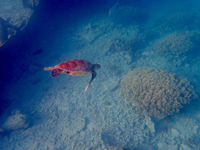The foraging behaviour of flatback (Natator depressus) and olive ridley (Lepidochelys olivacea) marine turtles in northern Australia is understudied. We used satellite telemetry to investigate the location of foraging habitats of flatbacks and olive ridleys. Our results have identified key areas for conservation initiatives and informed management strategies for marine turtle species and foraging areas. Photograph by Mark Hamann.
WR24054 Abstract | WR24054 Full Text | WR24054PDF (1.8 MB) Open Access Article













